Student Information System
Ngawang Tenzin1, Pema Namgang2, Jigme Singye3, Tshering Deker4, Tshering5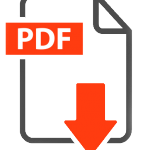
Information Technology Department, College of Science and Technology
*E-mail: eit2011017.cst@rub.edu.bt1, eit2012018.cst@rub.edu.bt2, eit2012006.cst@rub.edu.bt3, eit2012034.cst@rub.edu.bt4, tshering.cst@rub.edu.bt5
Abstract
Student Information System (SIS) is a web-based application developed for managing the records of students in the College. The system is redeveloped using the PHP Laravel framework. It handles student related information such as registration, managing and updating their information, course subscription, fees and individual remarks. The first version of software was developed in 2015. Authors worked on development of second version of SIS in 2016. This paper presents the second version of SIS. The second version of SIS is being evaluated and tested by the users such as student, staff, parents, provost and DSA. Starting winter semester 2016, the SIS version two is being deployed by college for managing student information system.
Keywords: Student Information System, SIS, Laravel Framework.
Introduction
With the world population growing at the rate of 1.13% per year (Worldometers, 2016), it’s becoming difficult to track, manage and store information of the people. Log books and checklists were used for maintaining the information of people but with the emerging technology the management and storage of people’s information has shifted towards software system.
With the continuous progression of schools, college and university throughout the globe, the information of students have doubled and redoubled (TANG Yu-fang, 2009).The colleges and universities are faced with a large number of information, and it became tedious to manage these information manually (TANG Yu-fang, 2009). So in order to manage this information efficiently and error free, a Student Information Management System is developed.
And also from the advent of University Credit System, division of campus, elective modules, school of departments, classes, teachers and students, it’s a must that the information be handled through a software system which does not succumb to a poor information delivery among students and teachers and within students (Yang Qingshan, 2010).
With Student Information System the advantages are incomparable, as computers manage student information. It provides quick search, convenient, high reliability, large memory capacity, confidentiality, long life and low cost with improved efficiency of Student Information Management by a large scale (Zhibing Liu, 2010).
Keeping these advantages in mind author proposed to work and improve on version two of Student Management System developed in 2015. Authors has successfully developed, evaluated and deployed the second version of software in the college. This paper presents technology used while developing this software.
Literature Review
Student Management System based on .Net Three-layer Structure
Student Information Management system has been implemented by (Yang Qingshan, 2010) using .Net Architecture for better standardization, information management, and three layer B/S structure. This architecture improves the security and maintainability.
Design and implementation of Student Information Management System
Similarly simplified friendly interface student management system has been designed and implemented with the use of Visual Basic 6.0 and the SQL Server 2000. This design has a fully functional, flexible and convenient application which provides friendly interface to the users (Zhibing Liu, 2010).
Student Information Access System via Bluetooth
K.A.C. Dushamali (2007) also presented their work and concluded the information can be accessed by teachers and students using Bluetooth. The system consist of a J2SE Server Application, a mobile phone, a Bluetooth dongle, web service which connects the database and the system, a database and a web interface.
A Project Report on Student Information Management System
Kapil Kaushik (2011) also built a student information management system with features like online registration of students, maintenance of students records and searching student records. Their system was built using HTML, JavaScript implementing PHP, MySQL (as back end). They also used Apache HTTP server and Dreamweaver (Kapil Kaushik, 2011).
Web Based Student Information Management System (SIMS)
S.R.Bharamagoudar, Geeta R.B and S.G.Totad also have built SIMS for maintenance of student information system solving the traditional way of managing the student records. The system was built using html, PHP and MySQL database.
Student Information System for Sebha University, Libya
They have devised a simple interface for the easy collation and maintenance of all manner of student information. They built a student database which had to be integrated with the web based system. And their student data system was used to collect and correct all student data at Sebha University (Almahdi Alshareef, 2015).
Design of RF Based Multithreaded RFID Student Attendance Management Information System
The paper proposed a better way of taking attendance of students using the RFID card and RFID card readers integrated with the Student Attendance Management Information System (SAMIS). The SAMIS collects and manages students’ attendance record from the RFID devices installed outside the lecture halls (Julius Quarshine Azasoo, 2014).
Student Management System
Dechen Wangmo (2015) et al. designed and built system software with features like course management, student semester registration, student bio data, disciplinary records and study information like course etc. Their system uses PHP framework named Laravel, html, java script, MySQL and Apache.
Our group reworked on the system developed by this group. Evaluated by the users and finally deployed in the college starting winter semester 2016.
Methodology
Fig.1 Methodology
We started our work reviewing literature of various different papers on Student Information System. Information collected were used as base data for analysis of SIS version one developed by previous group. System was redesign and coded. The code was tested till it reached to bug free system. After fixing the errors, the system was put to evaluation whereby different inputs from different users were tested. Finally we deployed the system in to server machine for its intended use.
System Design
Architecture
The architecture proposed is based on 3-tier system. A front end display allows the users (student, teachers, administration, dean and accountant) to create a profile. The information is stored in a database in the server and retrieved whenever it’s required using our application.

Fig.2 System Overview
The system is web based three-tier architecture developed keeping in mind that choice of users, the development time, flexibility and maintenance of the application.
Functionality
The Student Information System allows the students to upload their information, enroll to the courses and view the remarks given by their tutor. This system also allows the tutor to view the students enrolled in his/her course and give them remarks. The system also allows parents to view the remarks on their child’s progress given by the tutor. The college accountant can register himself to the Student Information System and manage the fees record for the Self-Financed students. Figure 3 show other functionality built in the system.
Fig.3 Application Functionality
Web Server
It is basically a program that understands the HTTP protocol and generates appropriate responses such as clients connect to the machine. Clients send a request, Server reads request, generates response and Client interprets response appropriately.
Web server respond to the client request in either of the following two ways: Sending the file to the client associated with the requested URL and the Generating response by invoking a script and communicating with database.
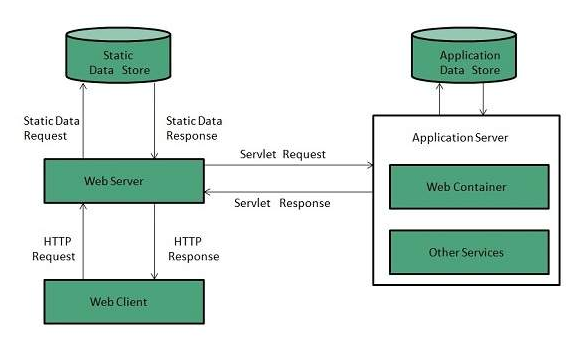
Fig.4 Web Server Architecture
When client sends request for a web page, the server search for the page if it is found then it will send it to client with an HTTP response.
If the page is not found, web servers will the send an HTTP response: Error 404 Not found. The SIS version two is developed to run in real time and accessible to all students, staff and the parent.
Database Design
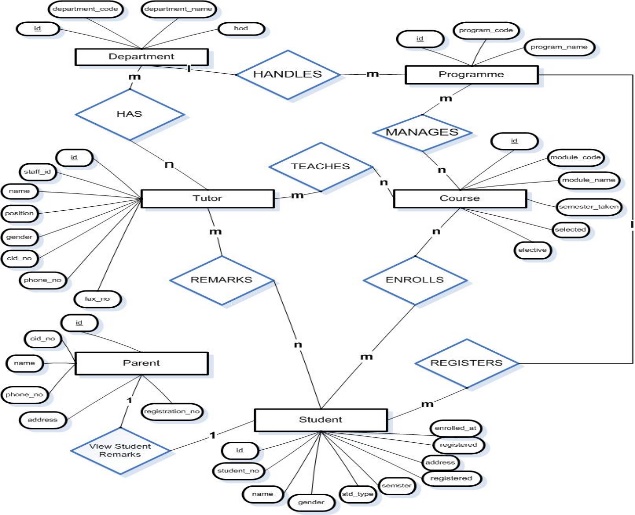
Fig.5 Entity Relationship Diagram
The detail over-all data base design of our work is shown in figure 5. In addition to existing system, we proposed new module called the “Parent Portal” that allows the parents to view their child’s progress.
Firewall
Firewall is a security device that grants or rejects access to traffic flows between an untrusted zone i.e., the Internet and a trusted zone i.e. a private or corporate network based on the predetermined security rules.
Firewalled daemon is used in our system. It provides dynamically managed firewall which support network/firewall zones to define the trustful network connections or interfaces. It also supports an interface for services or applications to add firewall rules directly. And we have implemented firewall in our system.
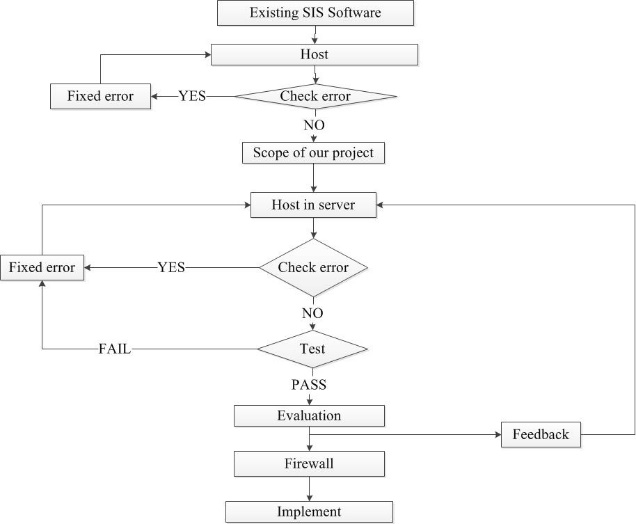
Fig.6 Firewall Flowchart for SIS
Implementation
This section presents the actual working of the system and the screenshots of the output. It contains the screenshots and explanation on the new added features on the system as well as the working of the System .i.e. Student Information System.
New Features
Our group reworked on the previous project and added new features and fixed bugs. The features and the bugs that we added are parent portal, registration, student information printing, index page redesign, remarks and the accountant module.
Back Up
The backup feature in the system is added, administrator can easily back up the data so that the admin can easily restore if ever crashes.

Fig.7 Back Up Command
Redesign Index Page
Group redesigned index page to the image shown in Figure 8. It has new sign up for user and Sign in login for existing users.
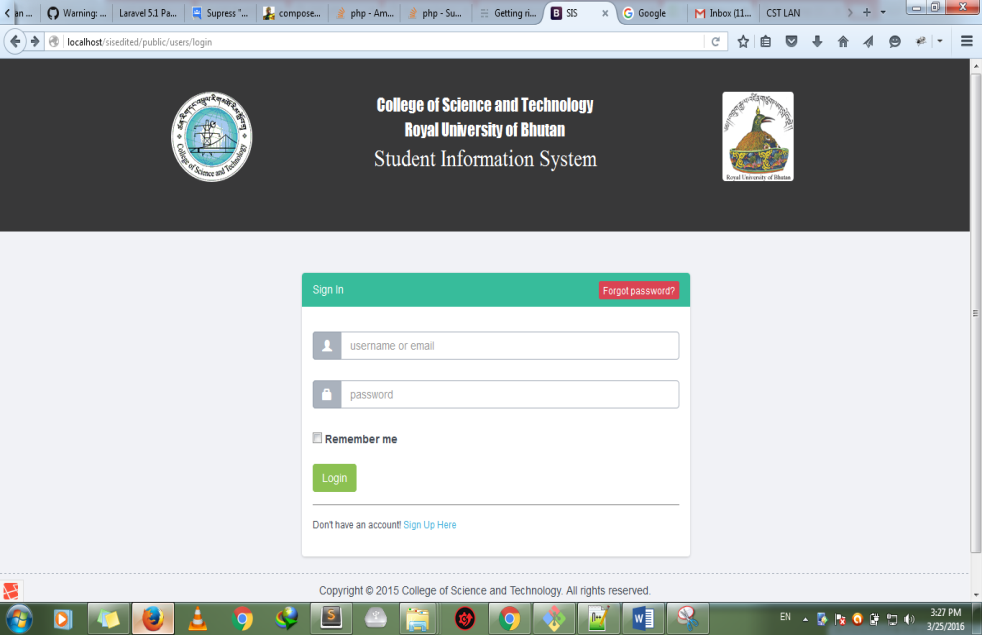
Fig.8 Home Page Redesigned
Redesign of Registration Form
SIS version one had problem with the identification of role in existing registration form, our group have re-designed the registration form. It now redirects to users profile page, once user conforms registration sent to their email.
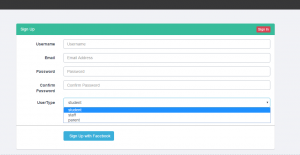
Fig.9 User Roles
Student Bio Printing
System is integrated with the print feature where the student can print their bio-data using the print functionality in the system. Figure 10 shows bio-data that can be printed by student.
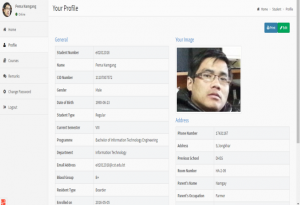
Fig.10 Student Bio-Printing
Parent Portal
The scope of the project includes the parent portal. In SIS version two, system allows the parent to access their child’s remark given by the various tutors.
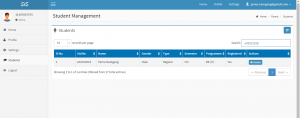
Fig. 11 Parent Portal Student View
Remarks
SIS version two has a feature to be used by the staff to add comments related with student. Registered staff can give remarks to the students in the system. The remarks given to student are made visible to parents, staffs and student. For example, if particular student have discipline problem, dean student affair can reflect it in the remarks field and this remarks are visible to other staffs and their parents. Figure 13 shows how it is being done.

Fig.12 Remarks Page

Fig.13 Remarks Added
Account Module
An account module is incorporated in SIS version two. Account official will be able to update the student fees record and payment transaction. Figure 14 shows the form used for updating fees related data.

Fig.14 Accountant Module
Staff
Staff can register, enroll the module and view their profile. As staff user, they update module being handled and view student details. Figure 15 show the profile view of staff. Figure 16 depicts module handled by tutor.
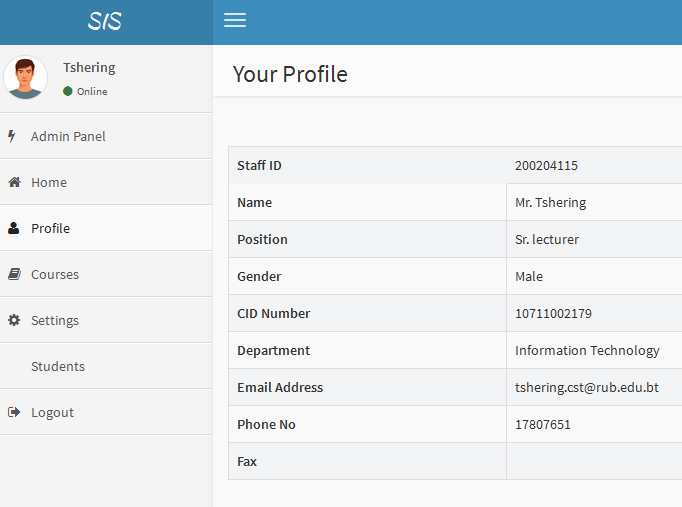
Fig.15 Staff Profile

Fig.16 Course Module View
Evaluation and Testing
After completion of development phase, system was installed in standalone computer as server. The components of the Student Information System have been tested by user such as Provost, Dean Student Affair, students, parents and tutor. The author received positive feedback and user acknowledge team for developing fully functional software for the college. Author has tested and recommends Firefox and Chrome browser.
Deployment
The College has currently deployed the Student Information System in a private network. Winter semester 2016, student registration is being done using SIS software.
Conclusion
College for so long has been exploring for computerization of student information. 2015 final year batch attempted the work and built version one. We reworked on system, named it as SIS version two, evaluated, tested and deployed it for managing student information in the local network. The security on server end has been added and system can be made accessible outside campus.
References
Almahdi Alshareef, A. A. (2015). Toward A Student Information System For Sebha University Libya. Fifth International Conference on Innovatiive Computing Technology (INTECH 2015), 6.
Dechen Wangmo, S. N. (2014). Student Management System. Phuentsholing: College of Science And Technology.
Julius Quarshine Azasoo, F. E. (2014). Design on RF Based Multithreaded RFID Student Attendance Management Information System. IEEE, 5.
K.A.C. Dushamali, V. F. (2007). Student Information Access System Via Bluetooth. Second International Conference on Industrial and Information System, ICIIS, 6.
Kapil Kaushik, A. A. (2011). A Project On Student Managemnet System. Maharishi Institute Of Engineering And Technology.
TANG Yu-fang, Z. Y.-s. (2009). Design and Implementation of College Student Information Management System Based on Web Services. School of Information Scince & Engineering, Shandong Normal University, Jinan, 250014, China, 5.
Worldometers. (2016, March 6). Retrieved from www.worldometers.info
Yang Qingshan, Z. X. (2010). Design and Implementation of College Student Managemnet Information System Based on .Net Three-layer Structure. Univeristy of Electronic Technology, Guilin, China, 3.
Zhibing Liu, H. W. (2010). Design and Implementation of Student Information Management System. International Symposium on Intelligence Information Processing and trusted Computing.
